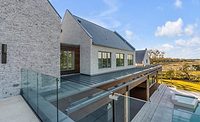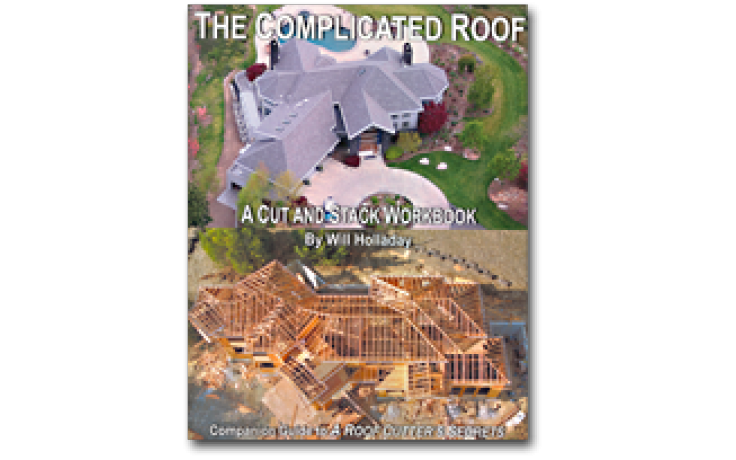Mad About Metal: Metal Roofing HeadQuarters Excels in Residential Metal Roofing
Stefan and Jonathan Boyer carve out a niche in a growing aspect of residential roofing

Metal Roofing HeadQuarters averages about 300 metal roofing projects per year with four full-time metal roofing crews and three salespeople. The company spent over a year renovating its new headquarters to include a dynamic showroom where customers can get used to seeing metal roofs in a residential setting.

“Although we’re one of the largest in our niche of the roofing industry, we’re still a small, family business. It may sound cliché, but our people are treated like members of our family,” said Metal Roofing HeadQuarters Co-founder Stefan Boyer (seated above) surrounded by members of his roofing family. Photos by Minerva Amputch Young of Forever Young Photography.

“We were definitely ahead of the crowd with residential metal roofing, and we’ve always tried to keep it that way,” said Metal Roofing HeadQuarters Co-founder Stefan Boyer, far right. He’s pictured with brother and business Co-founder Jonathan Boyer (left), and uncle Robin Wells, who became a minority owner in 2016.



Stefan and Jonathan Boyer knew what kind of roofing business they didn’t want to run.
Working together for a family member for about eight years, they saw enough examples of inefficiencies and missed business opportunities that they knew they had to make a change. Or at least try doing things a little differently on their own.
They made that happen in March 2015 when they formed Metal Roofing HeadQuarters in their hometown of Birmingham, Ala.
The entrepreneurial spirit runs strong in Boyer blood. The family has been in the home improvement industry since 1959, when their grandfather started his first metal siding company. Stefan proudly joined the family lineage in 2004 by working for an uncle selling metal roofs. The timing probably couldn’t have been better to launch a career as hurricanes Ivan and Katrina — two of the costliest storms on record in terms of damage — struck in consecutive years.
Stefan said he saw an opportunity, and was hooked.
“I obviously started at a very busy time,” said Stefan, who also carries the title of marketing and sales manager. “I fell in love with the concept of residential metal roofing, and I’ve been working in the business ever since. We were definitely ahead of the crowd with residential metal roofing and we’ve always tried to keep it that way.”
The company he owns now specializes in metal roofing systems, but unlike the majority of the metal market, focuses primarily on residential properties. Roughly 90 percent of all business is reroofing residences in their core market and a branch location in Mobile, Ala., along the volatile Gulf Coast.
While it was difficult at the start to carve a niche in the traditional roofing market dominated by asphalt shingles, the Boyer brothers entered the fray on the cusp of major changes stoked by technological enhancements and other devastating weather events. They’ve created a space for metal, to say the least, and are intent on growing it.
The company recently surpassed $20 million in sales — a personal milestone for the brothers. Their success also garnered some national media attention for appearing on syndicated shows.
It happened fast, but not without hard work, shrewd planning and some luck.
“Like most companies, we started small and lean, we did almost everything ourselves,” Stefan said. “We had a non-compete agreement that limited our geographic areas for a year, but it didn’t take long for our former employees to start reaching out about coming to work with us.”
Within a year, the company established a permanent headquarters and renovated the facility to include a showroom, which became a key component to closing deals. Customers could learn about the benefits of having a metal roof when it comes to longevity and potential energy savings. There were few places — aside from a random house or two every few miles — where they could see what metal roofs looked like.
Metal Mania
That scenario is changing across the country. Due to the continued demand for sustainable roofing products and systems, metal is increasingly becoming a viable option discussed around the kitchen table.
In 2017, the Metal Roofing Association (MRA) reported survey data indicating the residential metal roofing market grew to 14 percent, second only to asphalt.
With a strong presence already in Florida, Pennsylvania, California, New York, North Carolina and Texas, the MRA expects metal roofing demand to continue to rise in regions experiencing climate extremes, and where environmental awareness is high. Specifically, the MRA forecasts growth in Colorado, Washington, Oregon and Arizona.
Contractors and suppliers are paying attention, too. Survey data from RC’s 2019 State of the Industry Report showed metal is increasingly on a contractor’s mind.
More than half of survey respondents indicated residential metal roofing sales increased in 2018, and even more (57 percent) said they expected sales to increase in 2019. The survey data also revealed that for the first time, more than three-quarters of all respondents (76 percent) indicated they were involved with metal roofing, and that it accounted for about 13 percent of overall sales revenue.
Yet the lack of qualified metal roofing contractors remains an issue when it comes to meeting local demand, Stefan said.
Small but Mighty
That’s why taking care of Metal Roofing HeadQuarters’ 24 full-time employees is paramount. Stefan said it begins by ingraining a safety-first culture that includes regular Occupational Safety and Health Administration (OSHA) training. High-quality safety equipment is also provided and maintained by the company.
“Our people in the field understand that we’re not in a race,” said Jonathan, director of operations. “The goal is to produce a properly installed roof system with no injuries, regardless of how long the job takes.”
Jonathan has supervised the majority of the employees on the roof for a decade or longer, and they know what to expect, he said. Crews are also covered under a $1 million worker’s compensation policy, which the brothers are proud to say they’ve never had to use.
“He’s very hands-on and involved with his guys,” Stefan said of his brother. “He gets in the field with them regularly, goes above and beyond to make their jobs easier, and has a close personal relationship with all of them. We have happy workers, and happy workers seem to provide higher-quality workmanship.”
The Boyers also emphasize training, using both in-house and third-party programs. Workers in the field attend manufacturer-sponsored training programs annually, and they also take advantage of training sessions offered during the industry’s large events, such as METALCON. The sales team and office staff are trained extensively in-house, and are cross-trained to better serve customers when necessary.
The Boyers said they also feel like experience is the best training, and by making employee retention a major priority they’ve seen good results. The core group in the organization, which includes five office employees, three salespeople and three install teams, has worked together for more than 10 consecutive years.
“Although we’re one of the largest in our niche of the roofing industry, we’re still a small, family business. It may sound cliché, but our people are treated like members of our family,” Stefan said.
The brothers also offer employees performance incentives, including iPads, health insurance, auto allowances and an IRA that the company contributes to. There are also cash bonuses, which are earned based on completed job volume and the fewest callbacks on warranty work.
Inspiring a lot of production out of a small group of people can frequently open up companies to potential problems with quality installations. However, the Boyers inspect what they expect. Every customer completes a post-job survey, rating every aspect of the operation from marketing to jobsite clean-up.
To the Forefront
The Boyer brothers love metal, and they’re not afraid to show it.
They’re actively involved in the MRA and take proactive steps to increase their visibility while also educating the consumer about the benefits of installing a metal roof. Not long after launching, their work appeared on the “Lakefront Bargain Hunt” show on HGTV, and more recently appeared on the nationally-syndicated home improvement show “Today’s Homeowner with Danny Lipford.”
The message is usually the same when meeting with homeowners: there’s more of an initial spend with a metal roofing system; however, by spending more upfront on a more durable product, they’ll save on energy and maintenance costs over time.
Being that high profile with roofing projects can come with an added degree of pressure, particularly when you’re the new company looking to enter the market with a differentiating product. But the brothers know the secret to success: the metal roof will sell itself to educated clients.
“We have a somewhat complicated and detailed product, so we like to educate people first,” Stefan said. “Our approach with customers is more consultative than sales driven. The more someone learns about metal roofing, the more they’ll love it.”
Looking for a reprint of this article?
From high-res PDFs to custom plaques, order your copy today!












